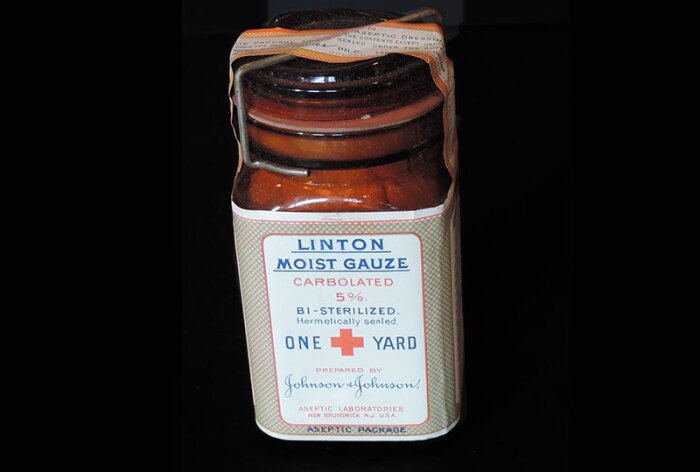
When the company was founded in 1886, sterile packaging wasn't yet available—so delivering its surgical supplies and household hygiene products to hospitals and consumers required ingenuity and design smarts. Here's the story of the changing face of packaging at Johnson & Johnson.
As the 20th century progressed, so too did packaging innovations, including a wide variety of containers specifically designed to keep home health items hygienic. As a result, Johnson & Johnson’s products became not just better at keeping people healthy—but easier to use, too. (Tooth "cream" in a squeezable metal tube? It was a brilliant innovation in 1889!)
The company also made labels and packages more aesthetically appealing to consumers, updating the look of products to align with changing design styles and tastes.
Take a look at these 11 Johnson & Johnson products spanning the 1880s to 1950s and marvel at their old-school yet highly effective and innovative packaging.
1. 1886-1887: Tooth Cream in a Bottle :

Until the mid-1880s, people brushed their teeth using commercial “tooth powder:” You’d stick your toothbrush into a jar of powder shared with multiple family members (and all their germs). In 1886 to 1887, Johnson & Johnson's Zonweiss Tooth Cream (above) made its debut. It was packaged in a bottle with an applicator spoon that each family member could use individually, making brushing more sanitary. By 1889, the company came up with an even more hygienic way to package tooth cream: in squeezable metal tubes, similar to the toothpaste tubes we use today.
2. 1900s-1910s: Surgical Gauze Packed in Fruit Jars :

In 1886, Johnson & Johnson became the first manufacturer of mass-produced sterile surgical supplies. Ready-made sutures, absorbent cotton and gauze could prevent infection and save lives—but only if they were packaged in a way that would keep out germs. So the company turned to a familiar type of container: fruit jars, which could be sealed to keep the content sterile. The one above is from the 1900-1910s.
3.1900s: Easy-to-Cut Dental Floss :

In 1898, Johnson & Johnson was the first mass-market manufacturer of affordable dental floss (made from leftover suture silk). And in the early 1900s, the company's New Era Dental Floss hit store shelves in a glass container with a novel cutting mechanism on the lid.
4. 1905: Sutures Stored in Glass Tubes :

Another innovation to keep sutures sterile: thin glass tubes. Beginning in 1905, Johnson & Johnson employed nine on-site glassblowers to make handblown glass packaging for its surgical sutures.
5. 1910s: Pretty Tins for Adhesive Plaster :

Adhesive plaster is the old-school word for adhesive tape, which was used to keep surgical dressings in place. Often packed in first-aid kits, adhesive plaster was also sold individually in colorful decorative tins, like this one from the 1910s.
6.1923: Medicated Plasters Packed in Cigar Boxes:

Cigar boxes used to package more than just cigars. Johnson & Johnson sold Dr. Grosvenor's Bellcapsic Plaster (aka, adhesive patches infused with medicine that was absorbed through the skin) in these iconic boxes as well. This box, from 1923, is decorated with pink and blue floral motifs, adding a bit of beauty to the packaging of a product meant to alleviate topical pain.
7.1929: Art Deco Indigestion Relief :

This circa-1929 bottle of Papoids, a papaya-based indigestion remedy that Johnson & Johnson first put on the market in 1887, sported a blue-glass Art Deco look—a style that reflected the might and power of the 20th century machine age. Even better, the bottle was small enough to be tucked into a pocket or purse. That made it ideal for consumers who needed discreet indigestion relief on the go.
8. 1930s: BAND-AID® Brand Adhesive Bandages Stored in Iconic Tins :

When they first hit store shelves in 1921, BAND-AID Brand Adhesive Bandages came in cardboard boxes. But in 1926, Johnson & Johnson began selling them in flat, square tin containers. The tins became as popular as the bandages themselves and were typically repurposed to hold small household items like coins, nails or buttons. The tins changed style and shape over the decades (the tin in the photo above dates back to the 1930s), and many are now prized collector’s items. In 1994, the company switched back to cardboard boxes.
9. 1930s: A First-Aid Kit With Flair:

Another example of midcentury Art Deco design: this sleek and streamlined first-aid kit from the 1930s. It was a perfect pick for consumers who wanted a kit that fit the style of the era. Johnson & Johnson manufactured a variety of first-aid kits beginning in 1888 geared toward different situations, such as household use, for traveling and to stash in your car.
10.1950s-early 1960s: Baby Oil in Tapered Glass Bottles :

Packaged in cylindrical glass bottles with screw-cap tops when it debuted in 1935, Johnson’s Baby Oil the first shelf-stable baby oil and part of the company's baby care line of products that launched in 1894 was designed to gently moisturize delicate baby skin after a bath and during diaper changes. The glass bottle above, from the 1950s to early 1960s, sports a midcentury shape tapered in the center.
11.1958: Germ-Proof Cotton-Ball Dispensing:

Today, cotton balls are typically packed in sterile plastic bags. But in 1958, Johnson & Johnson pioneered “cosmetic cotton” cotton balls packaged in a tin dispenser with a plastic top. Consumers could “pick” one puff at a time, never touching the other cotton balls and potentially exposing them to germs.






